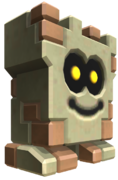Wallop
| Wallop | |||
|---|---|---|---|
 Artwork from Super Mario 3D Land | |||
| First appearance | Super Mario 3D Land (2011) | ||
| |||
| |||
Wallops[1] are enemies in Super Mario 3D Land. These stone creatures look like Whomps with small battlements on their heads and without arms. Their mouths resemble the mouths of Rhomps and later Grumblumps. Like Whomps, Wallops seem to be inspired by the Japanese mythological creature nurikabe, which block the path of travelers, just as Wallops do, but Wallops also bear a striking resemblance to Blocky from the Kirby series. Their name is a pun on "wall," due to how Wallops look and behave like walls, and "wallop," which means "to make a loud crushing noise" or "a large attack or beating." When the player is behind or a certain distance away from a Wallop, it stays dormant, with its pupils unlit and its feet retreated into its body. Once Mario or Luigi is in front of a Wallop, it attempts to block his way by mimicking his movements. A Wallop also jumps and slams the ground whenever Mario or Luigi jumps, after which the Wallop is unable to move for a few seconds, giving the player a chance to bypass it. By running in a direction and immediately turning the other way, Mario or Luigi can get past a Wallop without jumping. A Wallop can be defeated only from either Mario or Luigi turning into a statue using the Statue Leaf above or below the Wallop when it jumps. Wallops appear in World 3-1, World 6-4, World 8-6, Special 3-5, Special 6-1, Special 8-4, and Special 8-Crown.
Although no regular Wallops return in Super Mario 3D World, the game introduces a spiky variant known as Walleyes, which also attempt to block the player but cannot jump.
Profiles[edit]
- Super Mario 3D Land European website bio: "Annoying enemies that copy Mario's every move. When you jump, they jump!"
Gallery[edit]
Additional names[edit]
Internal names[edit]
| Game | File | Name | Meaning
|
|---|---|---|---|
| Super Mario 3D Land | romfs/ObjectData/Kabehei.szs | Kabehei | Portmanteau of「壁」(kabe, "wall") and「兵」(hei, "soldier") or「塀」(hei, "fence") |
Names in other languages[edit]
| Language | Name | Meaning | Notes |
|---|---|---|---|
| Japanese | ドンピョン[2] Donpyon |
Portmanteau of「ドン」(don, onomatopoeia for crashing sound) and「ぴょん」(pyon, onomatopoeia for bouncing noise) | |
| Chinese | 咚蹦[3][4] Dōngbèng |
Transliteration of the Japanese name; possibly from「咚咚」(Dōngdōng, "Thwomp") | |
| Dutch | Wallop[?] | - | |
| French | Passerapas[?] | Contraction of passeras pas ("will not pass") | |
| German | Kawummp[?] | Portmanteau of kawumm ("kaboom") and Wummp ("Whomp") | |
| Italian | Wallop[?] | - | |
| Korean | 폴짝쿵[?] Poljjak-Kung |
Portmanteau of "폴짝폴짝" (poljjak-poljjak, onomatopoeia for bouncing) and "쿵쿵" (Kung-kung, "Thwomp") | |
| Portuguese | Paralélio[?] | Portmanteau of parar ("to stop") and possibly the male given name "Hélio", as well as a rough homophone of paralelo ("parallel") | |
| Russian | Бабамс[?] Babams |
Onomatopoeia for something hitting the ground | |
| Spanish (NOE) | Rocopión[?] | Portmanteau of roca ("rock") and copión ("copycat") |
References[edit]
- ^ von Esmarch, Nick (November 13, 2011). Super Mario 3D Land PRIMA Official Game Guide. Prima Games (American English). ISBN 978-0-307-89386-4. Page 14.
- ^ October 19, 2015. Super Mario Bros. Hyakka: Nintendo Kōshiki Guidebook, Super Mario 3D Land section. Shogakukan (Japanese). ISBN 978-4-09-106569-8. Page 181.
- ^ 超级马力欧 3D乐园:冒险的舞台. iQue (Simplified Chinese). Retrieved December 20, 2019.
- ^ 超級瑪利歐 3D樂園 繁體中文版 - 香港任天堂網站. Nintendo.com.hk (Traditional Chinese). Retrieved December 20, 2019.
| Thwomps | ||
|---|---|---|
| Characters | Dossunmengyo • Gattai monster • Head Thwomp • Mr. Thwomp • Mrs. Thwomp • Sphinx Zō • Super Dossun • Thwomp Bros. • Thwomp Elevator • Waruiwa-gumi (leader) • Whomp King | |
| Species | Grindels | Grindel • Spindel |
| Pouncers | Omodon • Pouncer | |
| Whomps | Big Whomp • Whimp • Whomp | |
| Miscellaneous | Big Thwomp • Bone Thwomp • Karamenbo • Kongā • Mega Thwomp • Security Thwomp • Shoomp • Sniffle Thwomp • Spiked Thwomp • Star Thwomp • Stone Elevator • Tail Thwomp • Thwimp • Thwomp • Thwomp Platform | |
| Relatives | Grrrols | Grrrol • Mega Grrrol |
| Ka-thunks | Ka-thunk • King Ka-thunk | |
| Konks | Konk • Wonder Gottsun | |
| Spiny Tromps | Spiky Tromp • Spiny Tromp | |
| Thwacks | Thwack • Thwack Totem • Wonder Thwack | |
| Wallops | Wallop • Walleye | |
| Other | Bomp • Flomp • Grumblump • Rhomp • Stairface Ogre • Stone-Eye • Tox Box • Tsubushi • Walking Block | |


